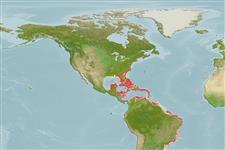Classificação / Names
Common names from other countries
Referência principal
Tamanho / Peso / Idade
Max length : 122 cm TL macho/indeterminado; (Ref. 5227); Peso máx. publicado: 25.0 kg (Ref. 5222); Idade máx. registada: 29 anos (Ref. 45400)
Length at first maturity
Lm 48.0 range ? - ? cm
Ambiente
; marinhas associadas(os) a recifes; oceanódromos (Ref. 51243); intervalo de profundidade 1 - 90 m (Ref. 5217)
Clima / Intervalo
Tropical, preferred 26°C (Ref. 107945); 35°N - 34°S, 92°W - 34°W (Ref. 5222)
Distribuição
Western Atlantic: Bermuda, Florida, Bahamas, Yucatan Peninsula and throughout the Caribbean to southern Brazil. Not known from the Gulf of Mexico except at the Campeche Bank off the coast of Yucatan, at Tortugas and off Key West.
Países | Áreas FAO | Ecossistemas | Ocorrências | Introduções
Descrição suscinta
Espinhos dorsais (total): 11 - 12; Raios dorsais (total): 16-18; Espinhos anais 3; Raios anais : 8. Caudal fin rounded in juveniles. Dorsal fin notched between forward spines; 3rd or 4th spine the longest. Bases of soft dorsal and anal fins covered with scales and thick skin; scales small and greatly overlapping. Ground color tawny in individuals in shallow water, shading to pinkish or red in those from deeper water, sometimes with an orange cast. Can change color pattern in a few minutes from almost white to uniformly dark brown depending on mood. Third and fourth vertical bars branch above lateral line forming a W-shaped mark. Several distinct black spots below and behind eye and a characteristic `tuning-fork shaped stripe on top of head, dividing just behind the orbits. (see also Refs. 5221, 5222, 5227 and 2458).
Status na Lista Vermelha da IUCN (Ref. 115185)
Perigo para os humanos
Reports of ciguatera poisoning (Ref. 30303)
Uso pelos humanos
Pescarias: espécies comerciais; peixe esportivo: sim; Aquário: Aquários públicos
Mais informação
ReferênciasAquaculturaPerfil para aquaculturaEstirpesGenéticaFrequência alélicaHereditariedadeDoençasProcessamentoMass conversion
Ferramentas
Relatórios especiais
Baixar XML
Fontes da internet
Estimates of some properties based on models
Phylogenetic diversity index
PD50 = 0.5000 many relatives (e.g. carps) 0.5 - 2.0 few relatives (e.g. lungfishes)
Nível Trófico
4.1 ±0.0 se; Based on diet studies.
Resiliência
Baixo, tempo mínimo de duplicação da população 4,5 - 14 anos (Musick et al. 2000 (Ref. 36717))
Vulnerabilidade
High vulnerability (63 of 100)
Categoria de preço
